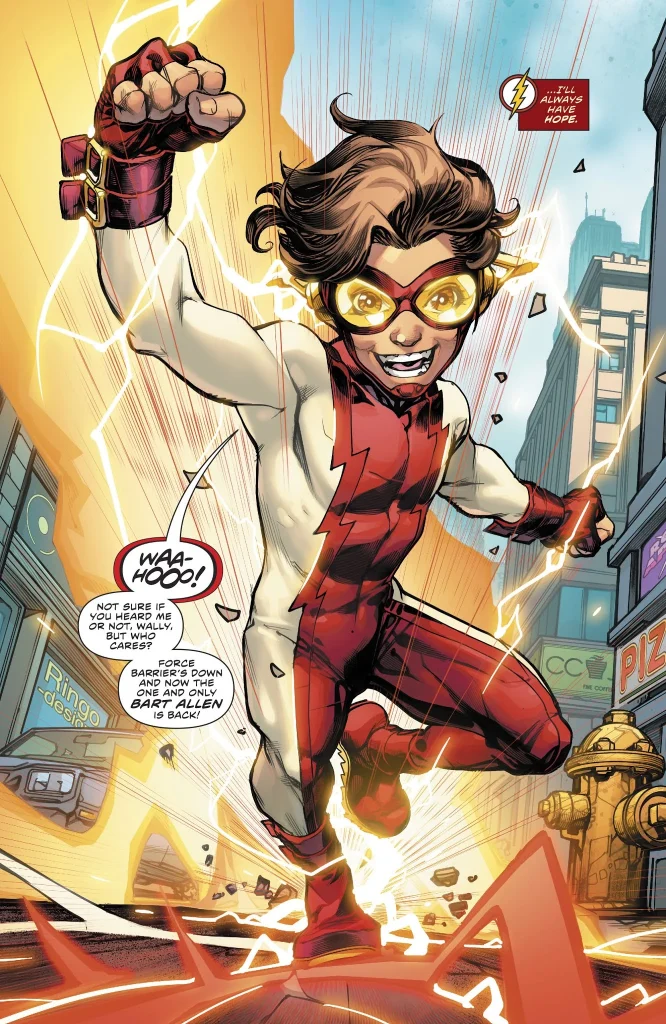
This Day In Comics: The Hyper-Fast Bart Allen First Appearance
The Flash legacy represents speed. It spans multiple generations of heroes. These speedsters safeguard the DC Universe. Every so often, a new blur of motion races onto the scene. April 12, 1994, delivered exactly that. On this date, DC Comics published The Flash #91 (Volume 2). This issue contained the whirlwind Bart Allen first appearance. Hailing from the future, this young speedster brought unique challenges and boundless energy. This post celebrates that significant debut. We will explore Bart Allen’s unique origins and his chaotic entrance into the present day. Our information is grounded in the comic’s history, crediting creators Mark Waid, Mike Wieringo, and Jose Marzan Jr. for bringing Bart to life.

Bart Allen’s story begins differently than most heroes. He was born in the 30th century. His connection to the Flash family ran deep, but so did his problems. Bart suffered from a dangerously hyper-accelerated metabolism. This condition caused him to age incredibly fast. Physically, he appeared twelve years old. Chronologically, he was only two. This rapid aging posed serious physical and mental risks. To cope, scientists placed him in a virtual reality machine. This machine simulated a world that matched his accelerated perception of time. It aimed to prevent mental health issues.
Out of Time: The Bart Allen First Appearance Story
The virtual reality solution proved insufficient. Bart’s condition remained critical. His grandmother, Iris Allen (herself a time traveler), knew drastic action was needed. She pulled Bart from the future. She brought him back to the present day. Her hope rested with the current Flash, Wally West. Iris believed Wally could help her grandson. Wally devised a risky but ingenious plan. He challenged Bart to an extreme race around the entire globe. This incredible burst of speed served a purpose. It shocked Bart’s hyper-metabolism. Consequently, his accelerated aging normalized. Wally saved Bart’s life. However, this solution created new problems.
Bart Allen spent his formative years in a simulated world. This environment protected him but also stunted his understanding of reality. He possessed no concept of danger. He acted purely on impulse. Leaping before looking became his standard operating procedure. This reckless energy defined the Bart Allen first appearance and his early adventures. Character origins like Bart’s, involving time travel and unique powers, often become favorite discussion topics for fans on sites like Comic Book Addicts. His arrival immediately shook up Wally West’s life. Wally quickly discovered Bart’s impulsive nature was more than just a quirk. It was a constant source of trouble.
The youth proved too difficult for Wally to handle alone. Wally West, despite his own experience as Kid Flash, needed help guiding this hyperactive protégé. Responsibility for Bart shifted. He was sent to live in Manchester, Alabama. His new guardian was Max Mercury, a veteran speedster with Zen-like wisdom. Max became Bart’s mentor. He attempted to teach the boy patience and caution. This task proved immensely challenging. Bart’s inherent nature clashed with Max’s teachings. It was during this time that Bart Allen embraced his own heroic identity. He proudly adopted the codename “Impulse,” a name perfectly reflecting his personality.
Mark Waid’s writing expertly captured Bart’s voice. Waid portrayed him not as malicious, but as genuinely naive about consequences. His impulsiveness stemmed from his unique upbringing. Mike Wieringo’s dynamic pencils brought Bart’s energy to life visually. Wieringo’s art style emphasized speed and youthful exuberance. Together, Waid and Wieringo defined Impulse for a generation of readers. Bart wasn’t just another sidekick; he was a force of nature. His interactions with Max Mercury provided both humor and heart. Max represented the patience Bart lacked. Their relationship formed the core of the Impulse solo series that followed his debut.
Living with Max provided some structure. However, Bart’s core impulsiveness remained. He often caused accidental chaos during his heroic efforts. Despite this, his good heart always shone through. He genuinely wanted to help people. He just processed the world faster than anyone around him. This unique perspective made him endearing to many readers. Bart Allen carved his own niche within the Flash family and the wider superhero community found within DC Comics. Though he would later take on other mantles like Kid Flash and even temporarily become The Flash himself, his time as Impulse remains definitive for many fans. His early stories explored themes of responsibility, mentorship, and finding your place when you literally move faster than everyone else.
The Lasting Impact of Impulse
The Flash #91 stands as a key issue in the modern Flash era. The Bart Allen first appearance on April 12, 1994, injected new energy into the speedster legacy. Bart’s chaotic charm, unique origin, and striking visual design made him an instant hit. He offered a different kind of speedster hero – one defined by boundless energy and a steep learning curve. His debut paved the way for popular solo adventures and memorable stints with teams like Young Justice and the Teen Titans.
In conclusion, Bart Allen’s arrival was a breath of fresh, hyper-fast air. His first appearance provided readers with a character full of potential and personality. From his time-bending origin to his mentorship under Max Mercury, Bart’s early days as Impulse remain a highlight of 90s comics. His legacy continues to resonate within the Flash family.What are your favorite Bart Allen moments, either as Impulse, Kid Flash, or The Flash? Let us know over on Twitter: https://x.com/comicbookaddt



